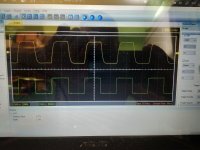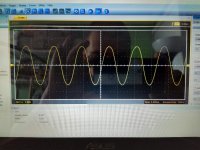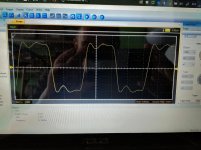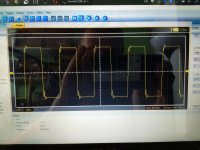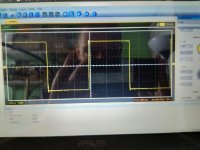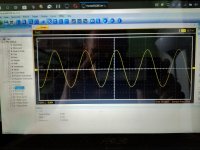Are you taking this measurement using the tube amp, or is the DDS connected directly to the primary side of the OT? The DDS is probably 50 OHM output. You have to put 1/4 of the nominal primary P to P Zin, in series with the DDS. The typical random wound power toroids have huge distributed capacitance in the windings, and using a 50 Ohm source then is able to overcome that. The typical tube output will not.
Last edited:
My experience has been with Antek toroids, all based on in-circuit measurements... I've used (just off the top of my head) 6AS7G(6N13S), 6336A, 6P3S, EL34, 6550, PCL86, PL509, 6AV5GA, parallel EL84, parallel 6V6, and I haven't measured the current 6SN7 implementation, but HF response in-room is within a dB with some basic recording and measuring setups when compared to a conventional EI transformer of similar impedance ratio. Good enough for me 
I usually include global negative feedback, usually to the cathode of a voltamp/concertina front end. I've played with cathode feedback with windings under the output tubes and it also worked well.
Once I get access to a scope again and some other advanced gear I want to go over it all again.
I usually include global negative feedback, usually to the cathode of a voltamp/concertina front end. I've played with cathode feedback with windings under the output tubes and it also worked well.
Once I get access to a scope again and some other advanced gear I want to go over it all again.
Last edited:
The sine wave looked fine in open loop at 60kHz. The square wave was awful. Still, when was the last time you build a feedback free amp while trying to "cut corners" by using PT's as OPT's? 
Attached is an open loop trace of 10kHz open loop square wave. Bottom trace is DDS.
Attached is an open loop trace of 10kHz open loop square wave. Bottom trace is DDS.
Attachments
Last edited:
Using a Norman Crowhurst Twin Coupled like output stage (two OTs, one as CFB, the other for plates) one can almost double the effective turns of these cheap toroids or any OT. (well, impedance is doubled) Cap cross couple them too, and you get a McIntosh equiv. OT.
I just special ordered some Edcor CXPP25-16-1.6K (not yet in catalog) OTs for making an 8 Ohm output (two 16 Ohm secondaries in parallel) 3.2K P to P primary 50 Watt total OT in Twin Coupled mode. Which is just perfect for the 17.5 to 24 Watt TV Sweep tubes.
There is an Edcor CXPP25-8-1.6K OT already in the catalog for making the Twin Coupled with a 4 Ohm output (8 Ohm secondaries in parallel) 3.2K P to P primary.
I just special ordered some Edcor CXPP25-16-1.6K (not yet in catalog) OTs for making an 8 Ohm output (two 16 Ohm secondaries in parallel) 3.2K P to P primary 50 Watt total OT in Twin Coupled mode. Which is just perfect for the 17.5 to 24 Watt TV Sweep tubes.
There is an Edcor CXPP25-8-1.6K OT already in the catalog for making the Twin Coupled with a 4 Ohm output (8 Ohm secondaries in parallel) 3.2K P to P primary.
I forgot to push the quote button, sorry. Here I go again.
Could you please post 10KHz square wave closed loop if you where so kind?
I'm tired of winding my own transformers and your choice looks promising.
Thanks in advance.
The sine wave looked fine in open loop at 60kHz. The square wave was awful. Still, when was the last time you build a feedback free amp while trying to "cut corners" by using PT's as OPT's?
Attached is an open loop trace of 10kHz open loop square wave. Bottom trace is DDS.
Could you please post 10KHz square wave closed loop if you where so kind?
I'm tired of winding my own transformers and your choice looks promising.
Thanks in advance.
I assumed it was directed at me.
I just ran some tests, here are the results... Improvement would be made by fine adjusting the NFB cap, but I only have so many values, and that was the best I could do with what I had. The source voltage was changed on these tests, the output voltage isn't to scale.
I just ran some tests, here are the results... Improvement would be made by fine adjusting the NFB cap, but I only have so many values, and that was the best I could do with what I had. The source voltage was changed on these tests, the output voltage isn't to scale.
Attachments
Last edited:
Improvement would be made by fine adjusting the NFB cap...
That's the most difficult part. Thanks a lot.
I assumed it was directed at me.
I just ran some tests, here are the results… Improvement would be made by fine adjusting the NFB cap, but I only have so many values, and that was the best I could do with what I had. The source voltage was changed on these tests, the output voltage isn't to scale.
Gotta say… that looks almost incredibly good given the output transformers you've chosen to use. Personally I don't mind a bit of way-high frequency ringing on the leading edges of 10 kHz square-waves. Just points to a pole fairly close (in interpreting your oscillograph traces) to 200 kHz with a Q of about 7. Nothing to worry about. I might be inclined to introduce a very small amount of anode-to-grid external capacitance (47 pF in series with 18 kΩ) in order to squash it, but that's about all.
GoatGuy
made my first 6EM5(vertical scanning tube) pp amp in the late 60's, i used a cheap opt, in a mono amp.......tubes borrowed from our bnw tv set....
later on when i dismantled the opt, i found out that the whole of the secondary was a one coil affair and the primary wound like a power traffo, no interleaving, but work it did and i can still remember tijuana brass by herb alpert sounded decent on an alnico jensen 8 inch full ranger...
but then at my age them how did i knew?
later on when i dismantled the opt, i found out that the whole of the secondary was a one coil affair and the primary wound like a power traffo, no interleaving, but work it did and i can still remember tijuana brass by herb alpert sounded decent on an alnico jensen 8 inch full ranger...
but then at my age them how did i knew?
I just would like to confirm other peoples experience with these power toroidals. I have measured response out to about 60khz with things relatively flat out past 30khz. I also got reasonable response down to 10hz (though at small power levels). They do benefit from low output impedence power tubes which counts out a lot of the usual audio valves. EL86 is an ideal candidate and dirt cheap in the P series (a quad of telefuncans can be had for less than a single EL84).
I have found variations between different brands but have had excellent successes with Telemac. I always find that there is a difference in response depending on which ends of the primary windings are driven, I think its the center taps which give best response (lowest interwinding capacitance), get it wrong and the ringing will be terrible and very audible and response will be down to 10khz and the bass will saturate significantly. I have seen various discussion about primary impedance with some people (generally those who haven't measured) reporting a few henries and others (generally those who have measured) reporting over 100 henries. Its now generally accepted that the smaller the transformer the better for primary inductance and I generally shoot for 4x VA of the desired output power.
Horses for courses.
Shoog
I have found variations between different brands but have had excellent successes with Telemac. I always find that there is a difference in response depending on which ends of the primary windings are driven, I think its the center taps which give best response (lowest interwinding capacitance), get it wrong and the ringing will be terrible and very audible and response will be down to 10khz and the bass will saturate significantly. I have seen various discussion about primary impedance with some people (generally those who haven't measured) reporting a few henries and others (generally those who have measured) reporting over 100 henries. Its now generally accepted that the smaller the transformer the better for primary inductance and I generally shoot for 4x VA of the desired output power.
Horses for courses.
Shoog
I generally shoot for 4x VA of the desired output power.
yes, considering that power traffos were designed for 60 hz, so x4 factor is plenty...
EL86 is perfect for this type of application, as is the 6C19P, 6AS7, and many sweep tubes.They do benefit from low output impedence power tubes which counts out a lot of the usual audio valves. EL86 is an ideal candidate and dirt cheap in the P series (a quad of telefunkens can be had for less than a single EL84).
The EL86 is a fantastic and easily overlooked tube. Affordable too. I just picked up a set of four NOS Polam tubes for $14 shipped, try that with EL84
I'll post up my EL86 amplifier in a new thread in the next few days hopefully. It uses toroids for power and output, and a 6N2P concertina front end. Very economical build.
Last edited:
I may be completely wrong here but I have always assumed that the core would saturate if the rated voltage of the winding was significantly exceeded at 50 Hz.
That is also my understanding. I've wondered why it is often recommended to go with much higher VA ratings than the power required. Some allowance needs to be made for the I2R losses due to the standing current, but what is the advantage in using a 100VA transformer for 25 watts? The larger transformer will have less turns per volt due to the larger core area (all else being equal).
With mains transformers you are forced to operate with very low Zaa if you want higher power at lower frequencies, so that you don't exceed ~240V rms @ 50Hz or 120V rms @ 25 Hz at the primary. For example if you want 15 watts at 25 Hz, Zaa = 960 neglecting losses. For an 8 ohm load and 230V primary this corresponds to a secondary of ~20V.
The choice of VA rating is a balance between having enough core to not prematurely saturate, vs having the most primary inductance which comes with smaller cores. Its a compromise but the performance is so much better than a comparably priced EI output transformer that is worth making the compromise.
All cheap transformers are going to suffer most with regard to their ability to sustain clean bass - but usually the top end will also suffer significantly with a cheap EI which gives the edge to the toroidal.
I2R losses in a toroidal power transformer are absolutely insignificant and much less than any EI OT. They can be ignored.
The sensible thing to do, and what I have done for the last 5years, is use a SS amp for frequencies below 400hz, which I would recommend for any valve setup, though probably at a much lower cut off frequency. Its one of those situations where unless you have tried toroidals in this application you aren't really in a position to comment and I have not seen anyone who has actually used them complain about the result. There are many restrictions placed on the toroidal user which maybe unacceptable to many people - but if they are applied then I don't see many complaints in real world builds.
Shoog
All cheap transformers are going to suffer most with regard to their ability to sustain clean bass - but usually the top end will also suffer significantly with a cheap EI which gives the edge to the toroidal.
I2R losses in a toroidal power transformer are absolutely insignificant and much less than any EI OT. They can be ignored.
The sensible thing to do, and what I have done for the last 5years, is use a SS amp for frequencies below 400hz, which I would recommend for any valve setup, though probably at a much lower cut off frequency. Its one of those situations where unless you have tried toroidals in this application you aren't really in a position to comment and I have not seen anyone who has actually used them complain about the result. There are many restrictions placed on the toroidal user which maybe unacceptable to many people - but if they are applied then I don't see many complaints in real world builds.
Shoog
Last edited:
The sensible thing to do is use a solid state amplifier for below–400 Hz, which I would recommend for any valve setup, though probably at a lower cut off frequency.
We agree it seems. Oh, the 400 Hz pole is debatable, but the idea is quite sound. I personally have become fond of semi-triamping. 6 pole Chebychev low-pass filter at 75 Hz to a mono solid state amplifier of 200+ watts, for a subwoofer. 4 pole Butterworth below 350 Hz for each left, right channel to a stereo solid state amplifier, running to speaker woofer cones directly. 4 pole Butterworth also at 350 Hz - high pass - sending that to valve amp, to stereo L+R midrange and tweeter speaker cones. Reliance on an in-speaker cross-over to get the mid-and-tweeter separation to happen.
Net result is remarkable. When needed, palpable thunder bass. Excellent bass response nominally, with stereo separation intact. Outstanding midrange and highs via valve. It works.
GoatGuy
- Home
- Amplifiers
- Tubes / Valves
- Output transformers a cheap alternative?
